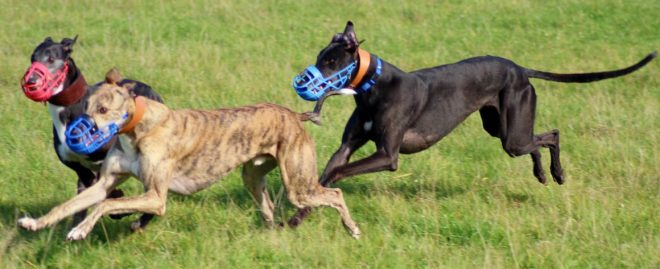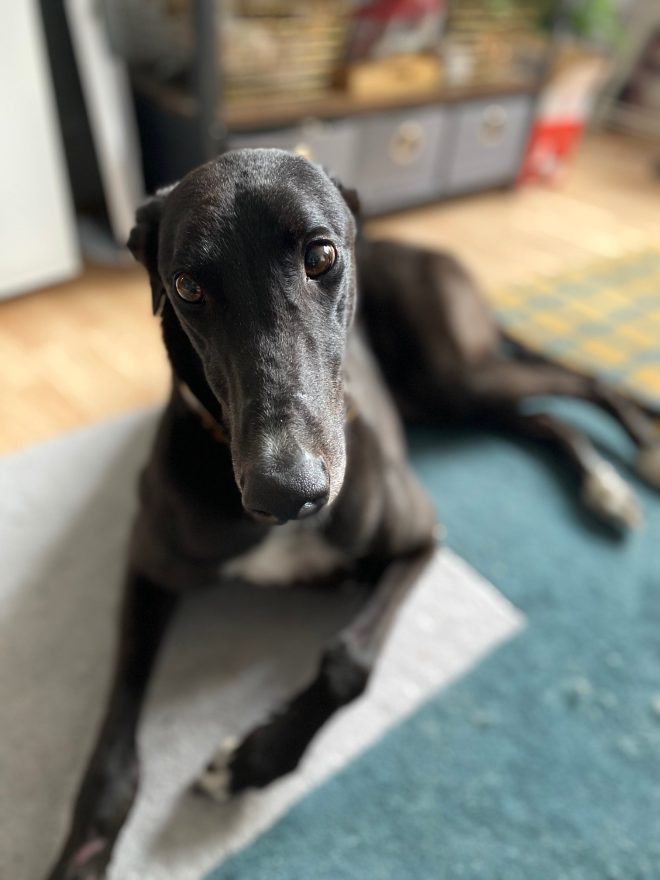ADOPTING AN EX-RACER GREYHOUND
Greyhounds are a wise and agile dog that are generally associated with the racing track. Many rescues work with the trainers to find them loving forever retirement homes, including ADM. Greyhounds make really incredible pets; they are chilled and have surprisingly low activity demands – completely the opposite of their reputation! Taking on a retired greyhound can be a wonderful and rewarding opportunity. If you can learn about and understand their previous life in racing, it will make the transition to becoming a pet simpler for them.

Learning about the breed and their characteristics is a great place to start if you’re looking to adopt a rescue greyhound. As a low-maintenance, gentle, and agile dog that doesn’t need a lot of exercise, they make a perfect pet for many Londoners. They are notorious couch potatoes and love a good cuddle and snooze on the sofa.
If you are interested in giving an ex-racer a forever home, read the information below, and consider if they are the right match for your lifestyle, family and home. Do bear in mind this information is based on our experience with ex-racers, however each dog will be entirely different and have unique personalities. If you have any additional questions, get in touch with us on email (info@alldogsmatter.co.uk) or phone (020 8341 3196)
The life of a racing dog
Racing greyhounds are bred for their fitness, rather than the physical characteristics of a purebred dog. For most greyhounds, life at racing kennels tends to be very predictable and structured – their life revolves around allotted times for feeding, grooming, exercise, and racing. Before they retire (usually between three and five), greyhounds won’t have experienced the sounds and activities of a home environment – they generally live inside a kennel owned by the trainers, usually with another greyhound, where they can remain muzzled for 21 hours a day.
Greyhounds are retired, and rehomed by charities, for various reasons. Unfortunately, injuries can also be common in the racing life of a greyhound – 35% of racing greys are injured each year – so bear in mind a latent injury could cause issues for your greyhound later in life. There are several reasons that a greyhound will be retired from racing, including a lack of prey drive meaning they do not chase and run, injury on or off the track, they are not fast enough to win the races, or a lack of interest in racing.

Settling a retired greyhound into your home
Greyhounds are naturally clean dogs, however as they are not used to being in a home environment they aren’t necessarily toilet trained. When regular toilet breaks are introduced, Greyhounds will pick up the routine quickly. As everything in the home will be entirely new for them, they need to be introduced to all experiences slowly and calmly. On this note, some Greyhounds struggle with the concept of windows/glass doors and will try to run through them, resulting in injury. If your dog starts to show this behaviour, consider putting coloured tape on the glass in an X to show them they cannot run through it.
When the dog arrives at your home, take them straight to the garden and encourage them to toilet. This will reinforce the toilet-training behaviour and will prevent them from marking in the home. When in the garden for the first few days, keep them on a lead/supervised. If you regularly have cats/small furries in the garden, the dogs should wear a muzzle outside until the small animals have learned to avoid the garden.

Although built for sprinting rather than endurance, these dogs make perfect companions on all types of walks. Due to their lack of body fat, they do tend to need thermals or coats when walking in colder temperatures. Be aware of any old injuries which may cause long-term discomfort and adjust exercise accordingly. Greyhounds have a small face to neck ratio, therefore need a specific collar suitable for sighthounds. Furthermore, as many of the racing greys have not encountered stairs before, they need to be introduced to these very slowly, and will not suit living in a flat, or house, with stairs up to the property. If stairs are in the home, greys will prefer carpeted ones to avoid slipping. Slowly train your dogs with high reward treats to go up the stairs. When going down, loosely hold their collar, or keep them on a lead, to prevent them falling as they learn to tackle them (adjust this depending on their behaviour in the home). Some dogs will pick stairs up straight away, whereas some can take years.
As Greyhounds very rarely meet other dog breeds when they are used for racing, it may take a while to adjust to meeting different types of dogs when out about. They are trained to chase ‘small furries’, and although not naturally aggressive, this behavioural trait can come to the surface when a cat or small dog runs in their eyesight. For this reason, a Greyhound should remain in a muzzle and on a lead out and about for the first few months at least. Once you understand the individual prey drive of your dog, you can decide when it’s ready to let them off.
Some greyhounds may indefinitely need to wear a muzzle and be on a lead, depending on their prey drive.
Feeding your Greyhound
Greys are the perfect height to be bin and counter-side scroungers in the home. They love food, and sometimes cannot resist investigating where they may find a few bits of human snacks! This may result in injury, or ingestion of something dogs can’t digest. To avoid this, keep food off the counter if unsupervised, and keep bins away from the dog’s reach. Research the food poisonous to dogs, and avoid leaving this unsupervised on the side.
As a tall breed, some Greyhounds prefer having bowls that are raised from the floor in order to reduce the strain on their necks. It may also be advisable to try using a slow-feeder if your dog is eating too quickly.
Greyhounds are generally fed a very high protein diet when racing, to help strengthen and develop their muscles. Once they are taken out of this lifestyle, they will soon lose the density. Do not feed your dog racing-grade food, as this will be too calorific for your couch potato. As a general rule, Greyhounds should put on an extra 5lb above their racing weight – however, this can vary from dog to dog. The tip of the backbone should be visible, and a bit of the back rib. Having a Greyhound that is overweight is dangerous for their health, as their bone structure is not designed to support the extra weight.

Top tips for adopted greyhounds
-
1. Keep your dog muzzled until you are sure about their behaviour around other dogs and prey drive, and on a lead until you are confident about recall – some dogs will have to remain on a lead and muzzle forever
-
2. Be aware of their food bowl and make sure not to overfeed while they lose their racing muscle
-
3. Take into consideration their previous life, and the behaviour that comes with it – prey drive, old injuries, lack of socialisation, and not being used to the home
-
4. Greyhounds make incredible pets. They will steal your heart (and your sofa!)
Ex-racing Greyhounds make loyal and loving pets, however their previous lifestyle and behaviour should be taken into account when bringing one into your home. A racing Greyhound is looking for a calm, affectionate, and understanding owner who will be able to work on their behavior in and outside the house. If you’re interested in adopting one, keep an eye on our Meet Our Dogs page, and social media for updates.

